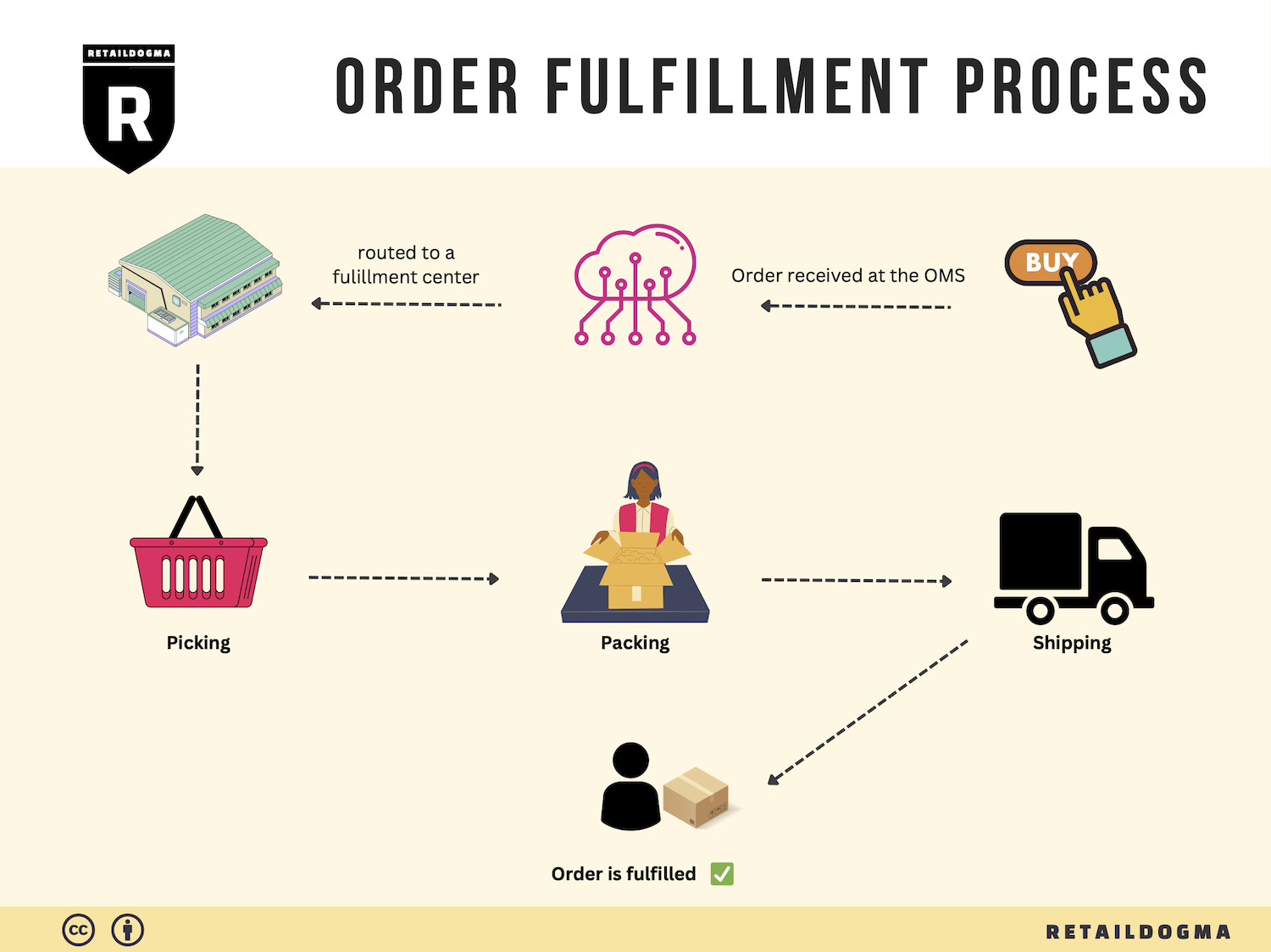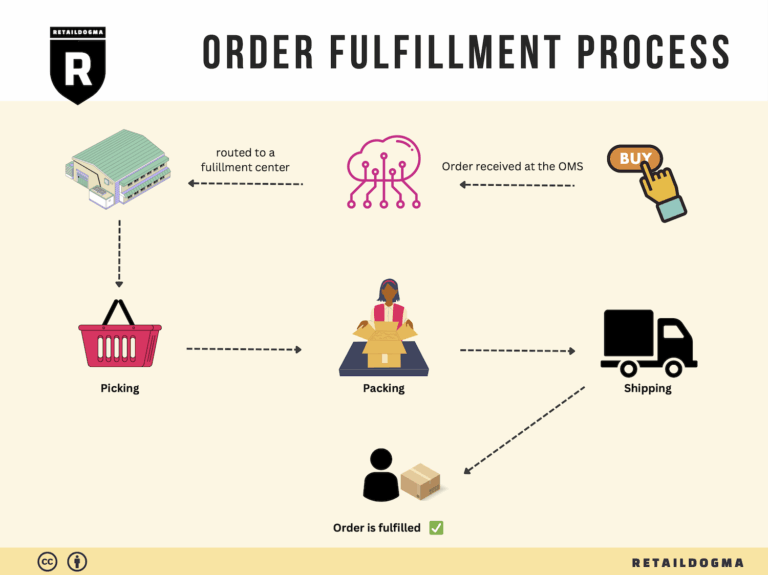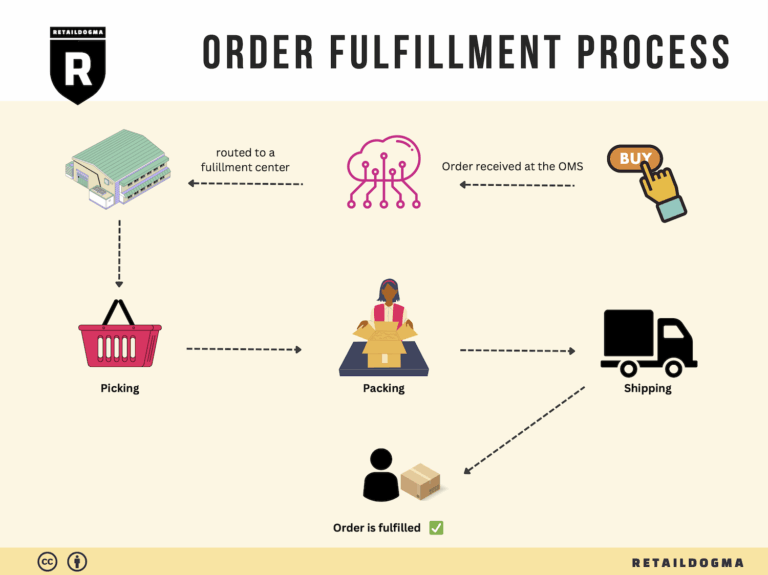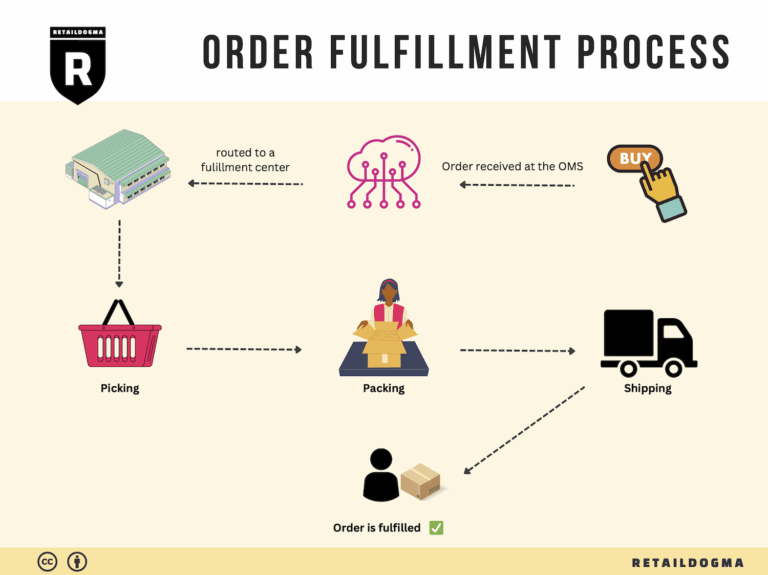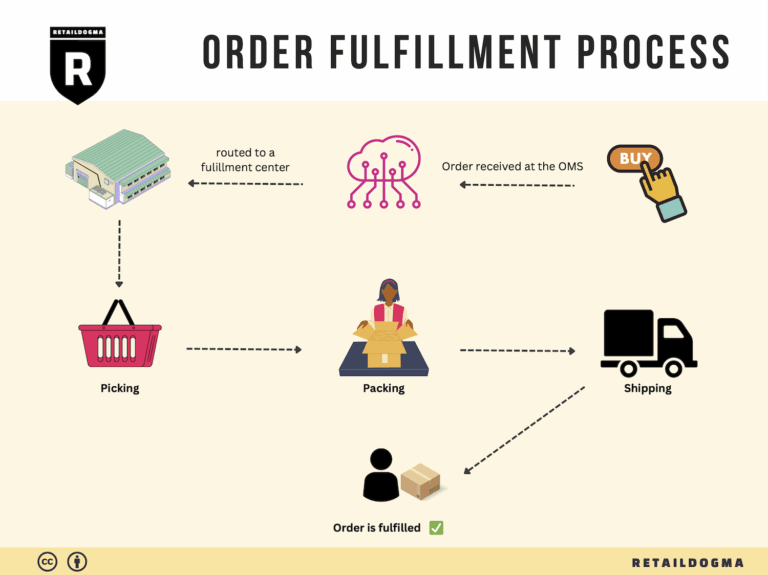How Order Fulfillment Works: A Step-by-Step Guide for Businesses
What is E-commerce Fulfillment? An Introduction for Growing Businesses
Navigating the Complexities of E-commerce Fulfillment
As an e-commerce business owner, you may find yourself overwhelmed with the intricacies of packing and shipping orders. As your sales grow, so do the challenges of efficiently managing logistics. The fulfillment process, which encompasses everything from inventory management to the actual delivery of products to customers, can quickly become a daunting task. Many entrepreneurs struggle to strike the right balance between providing excellent service and maintaining operational efficiency, leading to delays, errors, and ultimately dissatisfied customers.
In its simplest form, e-commerce fulfillment is the process of getting a product from your warehouse or fulfillment center to the customer’s doorstep. It involves several critical steps: receiving inventory, storing products, picking and packing orders, and shipping them out. Understanding this process is crucial for any growing business looking to scale without sacrificing customer satisfaction.
This guide will delve into various fulfillment models that can support your business as it expands. We will explore options such as Third-Party Logistics (3PL) and Fulfillment by Amazon (FBA), highlighting their unique advantages and how they can fit into your overall strategy. Each model offers different levels of service, flexibility, and control, so it’s essential to understand which aligns best with your business goals.
We will also cover the core services involved in e-commerce fulfillment, including inventory management, order processing, and customer service. These elements are vital for ensuring that orders are filled accurately and delivered on time, creating a seamless experience for your customers.
Choosing the right fulfillment partner can make or break your logistics strategy. We will provide insights on what to look for in a partner, including technology capabilities, shipping options, and scalability. The right partner can help you navigate the complexities of fulfillment, allowing you to focus on what you do best: growing your business.
Finally, pricing is a crucial factor in any fulfillment strategy. We will outline how to evaluate costs associated with different fulfillment models and services, ensuring you can make informed financial decisions.
The goal of this guide is to empower you with the knowledge and tools necessary to make smart decisions about your logistics. By understanding the nuances of e-commerce fulfillment, you can streamline your operations, enhance customer satisfaction, and ultimately drive growth for your business.
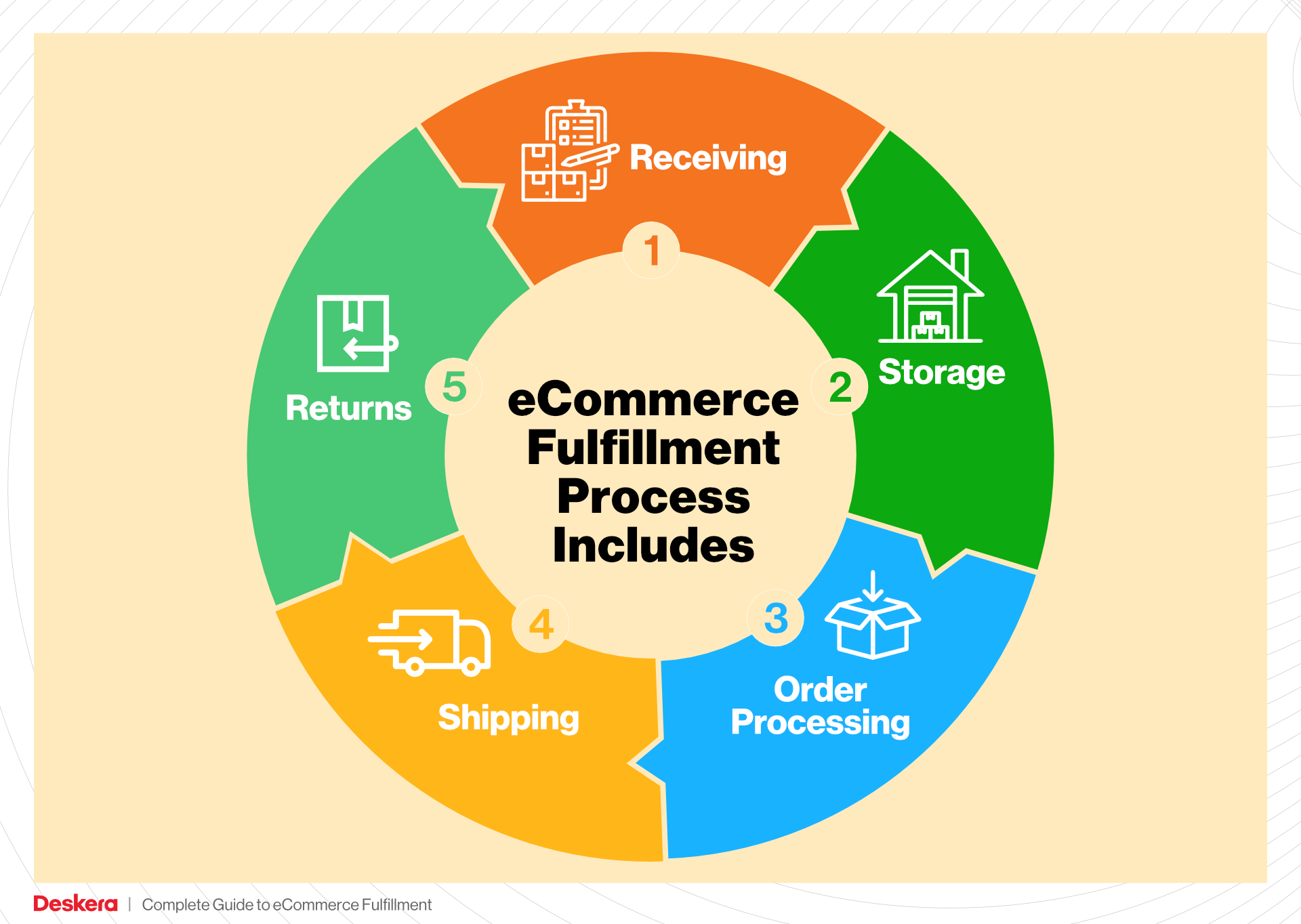
What You’ll Learn In This Guide
- What is E-commerce Fulfillment? An Introduction for Growing Businesses
- The Order Fulfillment Process: From ‘Buy’ Button to Customer’s Door
- Comparing Fulfillment Models: In-House vs. 3PL vs. Dropshipping
- A Deep Dive into Amazon FBA: Pros, Cons, and Who It’s For
- Core Services Offered by Fulfillment Centers
- How to Choose a Fulfillment Partner: A 6-Point Checklist
- Understanding Fulfillment Pricing: A Breakdown of Common Fees
- Frequently Asked Questions (FAQs) about Fulfillment
- Conclusion: Is Outsourcing Fulfillment the Right Move for Your Business?
- Important Disclaimer
The Order Fulfillment Process: From ‘Buy’ Button to Customer’s Door
1. Receiving Inventory
The order fulfillment process begins with receiving inventory, where products are delivered to the fulfillment center from various suppliers or manufacturers. During this stage, each shipment is thoroughly inspected to ensure that the quantity and quality of items match the purchase orders. This is crucial because any discrepancies can lead to stockouts or excess inventory, which can impact overall sales and customer satisfaction.
Key terminology: SKU (Stock Keeping Unit) – Each item is assigned a unique SKU that helps in tracking the product throughout the fulfillment process. This identification is essential for accurate inventory management, allowing businesses to maintain optimal stock levels.
Effective receiving processes involve the use of technology, such as barcode scanners, to streamline the verification of incoming goods. This step is vital not only for maintaining inventory accuracy but also for setting the stage for efficient storage and order fulfillment.
2. Warehouse Storage
Once inventory has been received and verified, the next step is warehouse storage. This involves organizing products within the fulfillment center to facilitate easy access and retrieval. Items are strategically placed based on their size, weight, and frequency of order to optimize space and minimize retrieval time.
Why is this important? Proper storage directly impacts the speed and efficiency of the picking process, which follows. A well-organized warehouse reduces the time employees spend locating products, thus enhancing overall productivity.
Key terminology: ABC Analysis – This inventory categorization method divides items into three categories (A, B, and C) based on their importance. Category A items are high-value with a low sales frequency, while Category C items are low-value with a high sales frequency. Understanding this classification can help businesses optimize their storage strategies and ensure that fast-moving items are easily accessible.
3. Order Picking
The next crucial step in the order fulfillment process is order picking, where employees retrieve items from the warehouse to fulfill customer orders. This step is often facilitated by pick lists, which detail the specific items and quantities needed for each order.
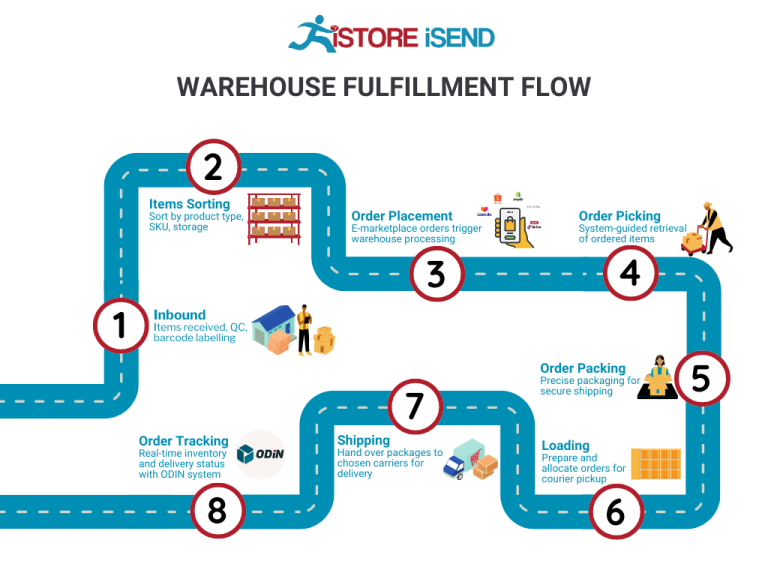
Efficient order picking is essential because it directly affects the speed at which orders are fulfilled and delivered to customers. Delays in this step can lead to increased lead times, which negatively impact customer satisfaction and can result in lost sales.
Key terminology: Pick Zones – In larger fulfillment centers, pick zones are designated areas where specific products are stored. This zoning strategy can streamline the picking process by allowing workers to focus on a smaller section of the warehouse, thus reducing the time spent walking between locations.
4. Order Packing
After items have been picked, they move to the order packing stage. This involves securely packing the products into boxes or envelopes, preparing them for shipment. Proper packing is critical to ensure that items arrive at the customer’s doorstep in perfect condition.
During this step, packing slips, which include order details and return information, are often included in the package. This practice enhances customer experience by providing essential information and promoting transparency.
Key terminology: Packing Materials – Various materials such as bubble wrap, packing peanuts, and boxes are used to protect items during transit. Understanding the right materials to use for different products can help reduce damage rates and enhance customer satisfaction.
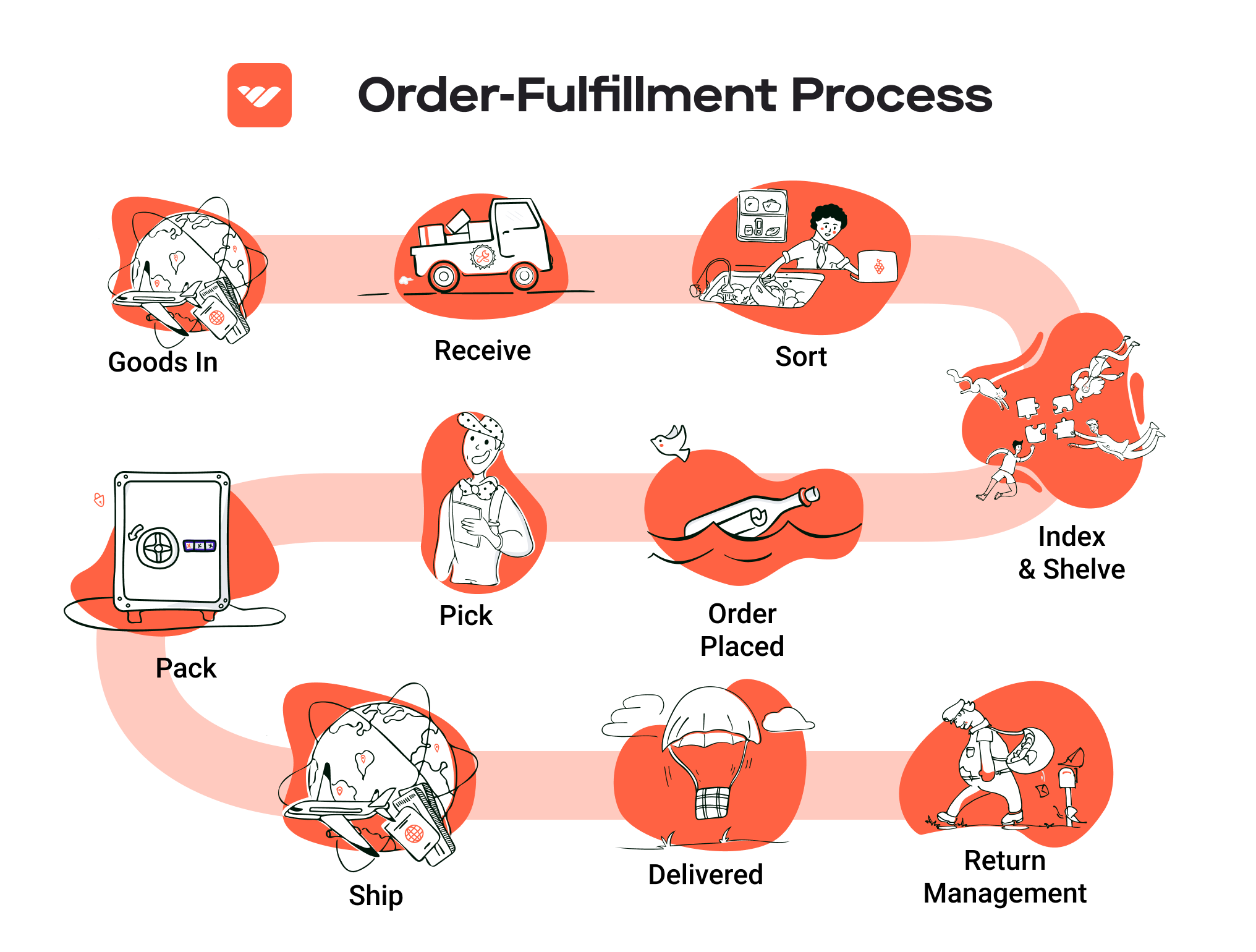
5. Shipping & Delivery
The final step in the order fulfillment process is shipping and delivery. Once packages are packed, they are labeled and sent to distribution carriers for delivery. This stage is where the fulfillment center interacts with logistics partners to ensure timely and efficient delivery to customers.
Why is this step important? Timely shipping is a key factor in customer satisfaction. In today’s e-commerce landscape, customers expect quick delivery times, and any delays can lead to dissatisfaction or negative reviews.
Key terminology: Last Mile Delivery – This term refers to the final leg of the shipping journey, where packages are delivered from the distribution center to the customer’s home. Efficient last-mile delivery solutions are critical for meeting customer expectations and maintaining a competitive edge in the e-commerce market.
In conclusion, understanding each step of the order fulfillment process—from receiving inventory to shipping and delivery—enables e-commerce businesses to optimize their operations, enhance customer satisfaction, and scale efficiently. By focusing on these critical components, businesses can ensure a smooth transition from the ‘buy’ button to the customer’s door.
Comparing Fulfillment Models: In-House vs. 3PL vs. Dropshipping
Fulfillment Model Comparison
| Model | Who Handles Inventory | Best For (Business Stage) | Key Advantage | Key Disadvantage |
|---|---|---|---|---|
| In-House Fulfillment | The business itself | Established businesses scaling up | Complete control over inventory | High overhead costs and resource demands |
| Third-Party Logistics (3PL) | A third-party logistics provider | Startups and growing businesses | Scalability and reduced operational burden | Less control over inventory and processes |
| Dropshipping | Supplier or manufacturer | New businesses and niche markets | Low upfront investment and risk | Lower profit margins and longer shipping times |
In-House Fulfillment
In-house fulfillment refers to the process where a business manages all aspects of inventory, storage, packing, and shipping directly. This model provides companies with complete control over their logistics operations, which can be a significant advantage when it comes to managing quality and customer service. Businesses that have established a solid customer base and are looking to scale their operations often find this model most beneficial. The ability to customize the fulfillment process according to specific business needs can enhance the customer experience, leading to higher satisfaction and loyalty.
However, in-house fulfillment comes with considerable challenges, particularly regarding overhead costs. Companies must invest in warehousing, technology, and labor, which can strain resources, especially for smaller businesses. Additionally, as demand fluctuates, scaling up or down can be cumbersome and require significant adjustments in staffing and inventory management. Businesses must also consider the logistics of shipping and handling, which can become complex as they expand their reach.
Third-Party Logistics (3PL)
Third-party logistics (3PL) involves outsourcing fulfillment operations to a specialized logistics provider. This model is ideal for startups and growing businesses that want to focus on their core competencies, such as marketing and product development, without getting bogged down by logistics. 3PL providers typically offer a range of services, including warehousing, order processing, and distribution, allowing businesses to scale operations quickly and efficiently.
One of the key advantages of using a 3PL is the reduced operational burden on the business. Companies can leverage the expertise and established networks of 3PL providers to improve shipping times and reduce costs. This is particularly beneficial for businesses looking to expand into new markets without the need for significant upfront investment in infrastructure. However, relying on a third party can lead to challenges related to control over inventory and fulfillment processes. Companies may find it difficult to maintain consistent quality and communication, which can impact customer satisfaction.
Dropshipping
Dropshipping is a fulfillment model where the retailer does not keep goods in stock but instead transfers customer orders to a supplier or manufacturer, who then ships the products directly to the customer. This model is particularly attractive for new businesses or those looking to enter niche markets without the burden of managing inventory. With dropshipping, entrepreneurs can launch their businesses with minimal financial investment and risk, focusing on marketing and sales rather than logistics.
The primary advantage of dropshipping is the low upfront investment required, as businesses do not need to purchase inventory until they make a sale. This significantly reduces the financial risk associated with starting a new venture. However, dropshipping also has notable disadvantages, including lower profit margins due to the costs associated with relying on third-party suppliers. Additionally, businesses may face challenges with shipping times and quality control, as they have less oversight of the fulfillment process. This can lead to longer delivery times and potential customer dissatisfaction, making it essential for dropshipping retailers to carefully select reliable suppliers.
Conclusion
Choosing the right fulfillment model is crucial for e-commerce businesses aiming to scale effectively. Each model presents unique advantages and disadvantages that must align with the company’s goals, resources, and market demands. In-house fulfillment offers control but comes with high costs, while 3PL provides scalability and operational efficiency at the expense of some control. Dropshipping minimizes risk and investment but can lead to lower margins and customer service challenges. By carefully assessing their specific needs and strategic objectives, e-commerce business owners can select the fulfillment model that best supports their growth and operational goals.
A Deep Dive into Amazon FBA: Pros, Cons, and Who It’s For
What is Fulfillment by Amazon (FBA)?
Fulfillment by Amazon (FBA) is a service offered by Amazon that allows e-commerce sellers to store their products in Amazon’s fulfillment centers. Amazon takes care of storage, packaging, and shipping of products directly to customers. This service also includes customer service and returns handling, providing a comprehensive solution for sellers looking to streamline their logistics and enhance their sales potential.
When a customer orders a product listed under FBA, Amazon handles the entire process, from picking the item from the warehouse to shipping it out. This service is particularly appealing to sellers who want to leverage Amazon’s vast distribution network, allowing them to scale their operations without investing heavily in their own logistics infrastructure.
How FBA Works
- Product Listing: Sellers create product listings on Amazon and enroll their products in the FBA program.
- Shipping to Amazon: Sellers ship their products to Amazon’s fulfillment centers. They can choose which fulfillment centers to send their inventory to, based on Amazon’s guidance.
- Storage: Once received, products are stored in Amazon’s warehouses until sold.
- Order Processing: When a customer orders a product, Amazon picks, packs, and ships it directly to the customer.
- Customer Service: Amazon manages all customer service inquiries and handles returns for FBA products, ensuring a smooth customer experience.
- Payment: Sellers receive payment for their sales, minus Amazon’s fees.
Pros of Using FBA
1. Prime Eligibility
One of the most significant advantages of FBA is that products become eligible for Amazon Prime. Prime members enjoy free two-day shipping, which can significantly increase your sales. Prime eligibility enhances visibility and customer trust, as many buyers prefer to purchase products that come with Prime benefits.
2. Customer Trust and Credibility
Products fulfilled by Amazon are often perceived as more reliable. Customers trust Amazon’s logistics and customer service, which can lead to higher conversion rates. The Amazon brand carries a level of credibility that can benefit sellers, especially those new to the e-commerce space.
3. Multi-Channel Fulfillment
FBA isn’t just limited to Amazon.com. Sellers can utilize FBA for orders from other sales channels, such as their own websites or other marketplaces. This multi-channel fulfillment capability allows sellers to centralize their inventory management while still reaching customers across different platforms.
4. Scalability
FBA allows sellers to scale their businesses rapidly without the complexities of managing their own warehousing and logistics. As sales grow, Amazon’s infrastructure can handle increased order volumes seamlessly.
5. Time-Saving
With Amazon handling storage, packing, and shipping, sellers can focus on other aspects of their business, such as marketing and product development. This time-saving aspect is particularly beneficial for small businesses and entrepreneurs who may not have the resources to manage logistics effectively.
Cons of Using FBA
1. High Fees
While FBA provides a comprehensive service, it comes with a cost. Sellers must pay various fees, including storage fees for inventory and fulfillment fees per unit sold. These costs can add up, especially for low-margin products, potentially eroding profitability.
2. Strict Inventory Rules
Amazon has strict inventory management policies that sellers must adhere to. This includes limitations on how much inventory can be stored and requirements for labeling and packaging. Non-compliance can lead to additional fees or even account suspensions.
3. Commingling Risks
FBA utilizes a commingling inventory model, where products from different sellers are stored together. While this can streamline operations, it poses risks. If a customer returns a product that was damaged or defective, it may affect your seller rating, even if the issue was not with your product. Additionally, there’s a risk of counterfeit products affecting your brand’s reputation.
4. Loss of Control
By using FBA, sellers relinquish some control over their shipping and handling processes. This can lead to variability in service quality, as Amazon’s fulfillment centers handle the logistics. If there are issues with shipping times or product quality, sellers may find it challenging to address these concerns directly.
5. Limited Customization
Sellers have limited options for branding and packaging when using FBA. Unlike fulfilling orders in-house, where sellers can customize packaging to enhance brand identity, FBA products are typically shipped in Amazon-branded boxes, which can dilute brand presence.
Who is FBA Best For?
Fulfillment by Amazon is ideal for:
-
Small to Medium-Sized Sellers: Businesses that lack the resources to manage their logistics efficiently can benefit significantly from FBA. It allows them to scale operations without the burden of warehousing and shipping.
-
E-commerce Entrepreneurs: New sellers looking to establish themselves on Amazon can leverage FBA to gain immediate access to Prime customers and benefit from Amazon’s credibility.
-
High-Volume Sellers: Sellers with a wide range of products or those experiencing rapid growth can efficiently manage inventory and fulfillment through FBA, allowing them to focus on strategic growth.
-
Businesses Seeking Multi-Channel Sales: Brands that sell on multiple platforms can streamline their logistics by using FBA for all their orders, simplifying inventory management.
In conclusion, while Fulfillment by Amazon presents a robust solution for scaling e-commerce operations, it’s essential for sellers to weigh the pros and cons carefully. Understanding how FBA aligns with their business model will help them make informed decisions that drive growth and profitability.
Core Services Offered by Fulfillment Centers
Inventory Management & Warehousing
Fulfillment centers provide sophisticated inventory management and warehousing solutions that are essential for e-commerce businesses. Inventory management involves tracking and controlling stock levels, ensuring that products are available when needed without overstocking. This is particularly critical for businesses with diverse product lines and fluctuating demand.
By utilizing advanced inventory management systems, fulfillment centers can offer real-time visibility into stock levels, allowing businesses to make informed decisions about reordering and product launches. This minimizes the risk of stockouts, which can lead to lost sales and dissatisfied customers.
Moreover, fulfillment centers often employ technology such as RFID (Radio Frequency Identification) and barcode scanning to streamline inventory processes. This not only enhances accuracy in stock tracking but also reduces labor costs associated with manual inventory checks. As a result, e-commerce businesses can maintain optimal inventory levels, reduce carrying costs, and improve cash flow.
Pick and Pack Services
Pick and pack services are a fundamental component of fulfillment operations, involving the selection of ordered items from inventory and packing them for shipment. Fulfillment centers employ efficient picking strategies—such as batch picking, wave picking, or zone picking—to optimize the process, ensuring that orders are fulfilled quickly and accurately.
The benefits of efficient pick and pack services are manifold. Firstly, they significantly reduce order processing times, allowing businesses to meet customer expectations for fast delivery. In an era where same-day or next-day shipping has become the norm, a reliable fulfillment center can be a game-changer for e-commerce companies looking to compete in the marketplace.
Additionally, accurate packing minimizes shipping errors, which can lead to costly returns and customer dissatisfaction. Fulfillment centers also utilize packing materials that ensure products are protected during transit, further enhancing the customer experience. Ultimately, effective pick and pack services contribute to increased customer loyalty and repeat business, essential for scaling e-commerce operations.
Kitting and Assembly
Kitting and assembly services offered by fulfillment centers involve the grouping of individual items into ready-to-sell sets or kits, often including assembling products that require multiple components. This service is particularly beneficial for businesses that sell products that are frequently purchased together, such as gift sets or DIY kits.
By outsourcing kitting and assembly to fulfillment centers, e-commerce businesses can save time and labor costs associated with these processes. This allows them to focus on core business activities, such as marketing and product development. Moreover, kitting can enhance the perceived value of products, encouraging customers to purchase sets instead of individual items, which can lead to higher average order values.
Additionally, fulfillment centers can efficiently manage seasonal or promotional kitting, allowing businesses to respond quickly to market demands without the need for extensive internal resources. This flexibility is critical for businesses looking to scale rapidly, as it enables them to adapt their offerings without compromising on quality or delivery times.
Returns Management (Reverse Logistics)
Returns management, or reverse logistics, is an often-overlooked but vital service provided by fulfillment centers. As e-commerce continues to grow, so does the volume of returns, making it essential for businesses to have a streamlined process in place to handle them effectively.
Fulfillment centers facilitate the returns process by providing customers with easy return options, including return labels and drop-off locations. They also manage the inspection and restocking of returned items, ensuring that products are returned to inventory quickly and efficiently. This reduces the financial impact of returns and helps maintain accurate inventory levels.
An effective returns management system can enhance customer satisfaction, as it demonstrates a commitment to customer service. Businesses that handle returns well are more likely to retain customers, as they feel valued and supported. Furthermore, insights gained from returns data can inform product development and inventory decisions, allowing businesses to identify trends and areas for improvement.
In conclusion, leveraging the core services offered by fulfillment centers—inventory management and warehousing, pick and pack services, kitting and assembly, and returns management—can significantly enhance the operational efficiency of e-commerce businesses. By partnering with a fulfillment center, businesses can focus on growth and customer satisfaction, ultimately driving sales and scaling their operations effectively.
How to Choose a Fulfillment Partner: A 6-Point Checklist
Location & Warehouse Network
The geographical location of your fulfillment partner is critical for ensuring timely deliveries and minimizing shipping costs. A strategically located warehouse network can significantly reduce the transit time to your customers, which is essential for maintaining high service levels, especially in e-commerce.
Key Questions to Ask:
– Where are your warehouses located, and how do they align with my target customer base?
– Can you provide details on your shipping zones and how they impact delivery times?
– What transportation options do you utilize for last-mile delivery, and how do you ensure efficiency?
Technology & Integrations
In today’s digital landscape, technology is a cornerstone of efficient fulfillment operations. A partner that employs advanced technology—such as warehouse management systems (WMS), order management systems (OMS), and real-time tracking—can streamline processes, reduce errors, and enhance customer satisfaction.
Key Questions to Ask:
– What technology do you use to manage inventory and orders?
– How does your system integrate with my existing e-commerce platform (e.g., Shopify, WooCommerce, Amazon)?
– Can you provide real-time visibility into my inventory levels and order statuses?
Specializations (e.g., Cold Storage, Oversized Items)
Not all fulfillment partners are equipped to handle every type of product. If you deal with specialized items—such as perishable goods requiring cold storage or oversized items that need special handling—it’s crucial to partner with a provider that has the necessary capabilities.
Key Questions to Ask:
– Do you have facilities that cater to specialized inventory, such as cold storage or oversized items?
– What protocols do you have in place for handling and storing specialized products?
– Can you share case studies or examples of clients with similar needs?
Scalability & Capacity
As your business grows, your fulfillment partner must be able to scale alongside you. This includes having the capacity to handle increased order volumes, as well as the flexibility to adapt to seasonal fluctuations or unexpected surges in demand.
Key Questions to Ask:
– What is your current capacity, and how do you manage peak seasons?
– How quickly can you scale operations to meet increased demand?
– Can you accommodate seasonal or promotional spikes in order volume?
Pricing and Contracts
Understanding the pricing structure and contract terms is vital for budgeting and avoiding unexpected costs. Look for transparency in pricing, including any hidden fees, and ensure the contract aligns with your business goals.
Key Questions to Ask:
– What is your pricing model (e.g., per order, per item, monthly fees)?
– Are there any additional fees I should be aware of (e.g., storage fees, handling fees)?
– What are the terms for contract length and cancellation? Are there any penalties for early termination?
Customer Support & Reviews
Effective communication and support are essential for a successful partnership. A responsive customer support team can help resolve issues quickly and keep your operations running smoothly. Additionally, reviewing customer testimonials and feedback can provide insights into the partner’s reliability and service quality.
Key Questions to Ask:
– What customer support options do you offer (e.g., phone, email, chat)?
– What is your average response time for support inquiries?
– Can you provide references or case studies from current or past clients?
By considering these six critical areas when choosing a fulfillment partner, you can ensure that your logistics operations are optimized for efficiency, scalability, and customer satisfaction. A well-chosen fulfillment partner can significantly enhance your e-commerce business’s performance, ultimately leading to increased sales and customer loyalty.
Understanding Fulfillment Pricing: A Breakdown of Common Fees
Initial Setup Fees
When partnering with a fulfillment center like Amazon’s ROC1, businesses often encounter initial setup fees. These fees cover the administrative costs associated with onboarding your products into the system. Typically, this includes creating product listings, integrating inventory management systems, and setting up your seller account.
The calculation of these fees varies by provider but usually includes a one-time charge that can range from a few hundred to several thousand dollars, depending on the complexity of your operations and the number of SKUs you plan to manage. It’s essential to clarify what services are included in the setup fee to avoid hidden costs down the line.
Receiving Fees
Receiving fees are charged when your products arrive at the fulfillment center. This fee covers the labor and equipment costs for unloading, inspecting, and storing your goods.
Typically, receiving fees are calculated on a per-unit basis or per pallet. For instance, a fulfillment center may charge $0.50 per item or $20 per pallet. It’s crucial to understand that these fees can vary based on the size, weight, and type of products being received. Ensure to communicate with your provider about any specific requirements that may affect these costs, such as special handling for fragile items.
Storage Fees (per pallet/bin)
Storage fees are incurred for keeping your inventory in the fulfillment center. These fees are generally calculated on a monthly basis and can vary significantly depending on the size of your products and the space they occupy.
Most fulfillment centers charge storage fees per pallet or per bin. For example, the fee might be $15 per pallet per month or $5 per bin. It’s essential to be aware of potential seasonal fluctuations in storage fees, as many providers increase their rates during peak shopping periods, such as the holiday season. Regularly reviewing your inventory levels can help you minimize storage costs by reducing excess stock.
Pick & Pack Fees (per item/order)
Pick and pack fees are charged for the labor involved in picking items from the warehouse and packing them for shipment. This fee is typically calculated per item or per order, depending on the fulfillment center’s pricing structure.
For instance, a fulfillment center may charge $1.00 per item picked and packed or a flat fee of $2.50 per order, regardless of the number of items. Understanding this fee structure is crucial, especially for businesses with varied order sizes. Efficient inventory management can help streamline the picking process, potentially reducing these costs.
Shipping Fees
Shipping fees are among the most significant costs in the fulfillment process. These fees are charged for transporting packages from the fulfillment center to the customer’s location. Shipping fees can vary based on several factors, including the destination, package weight, and shipping speed.
Most fulfillment centers offer tiered shipping rates based on weight brackets or flat rates for specific shipping options (e.g., standard, expedited). For example, you might pay $5 for packages under 1 lb, $10 for those between 1 and 5 lbs, and so on. It’s advisable to negotiate shipping rates with your provider, as many fulfillment centers have partnerships with shipping carriers that can lead to discounted rates.
Tips for Getting an Accurate Quote
-
Be Transparent About Your Needs: When requesting a quote, provide detailed information about your product types, order volumes, and any special handling requirements. This transparency helps fulfillment centers give you a more accurate estimate.
-
Request a Breakdown of Fees: Ask for a detailed breakdown of all potential fees, including those that may apply at different stages of the fulfillment process. This will help you understand the total cost of operations.
-
Consider Long-Term Costs: Look beyond initial setup fees and evaluate ongoing costs such as storage and shipping fees, especially during peak seasons. This will help you budget effectively.
-
Negotiate Terms: Don’t hesitate to negotiate fees and terms with fulfillment providers. Many are willing to offer discounts or better terms for long-term commitments or higher volumes.
-
Evaluate Multiple Providers: Obtain quotes from several fulfillment centers to compare pricing and services. This not only helps you find the best deal but also gives you leverage in negotiations.
By understanding these common fulfillment pricing models and following these tips, e-commerce business owners can better manage their logistics costs and scale their operations effectively.
Frequently Asked Questions (FAQs) about Fulfillment
1. What is the Amazon fulfillment center ROC1?
Amazon fulfillment center ROC1 is a state-of-the-art robotics facility located in Gates, New York. Spanning 2.6 million square feet, it employs over 1,000 workers and processes more than 700,000 packages daily. This facility utilizes advanced robotics technology to optimize the sorting, packaging, and shipping of products, significantly enhancing efficiency in the fulfillment process.
2. How does ROC1 differ from a traditional warehouse?
The primary difference between ROC1 and a traditional warehouse lies in its operational capabilities. While a warehouse is primarily focused on storing inventory, ROC1 is a fulfillment center designed for the entire order processing cycle, including receiving, sorting, packaging, and shipping products directly to customers. The integration of robotics and AI technology at ROC1 allows for faster processing times and more accurate order fulfillment.
3. What types of products are handled at ROC1?
ROC1 handles a diverse range of products, with approximately 26 million items stored on-site at any given time. This includes small packages, consumer electronics, household goods, apparel, and more. The facility is designed to efficiently manage a high volume of varied products to meet customer demand.
4. How does Amazon ensure timely delivery from ROC1?
Amazon achieves timely delivery from ROC1 through a well-structured logistics network. Once orders are processed at the fulfillment center, they are sent to local delivery stations, where they are prepared for the “last mile” delivery to customers. By strategically locating fulfillment centers like ROC1, Amazon minimizes transit times and enhances overall delivery speed.
5. What role does robotics play in ROC1 operations?
Robotics plays a crucial role in the operations of ROC1. The facility employs thousands of robots to assist with tasks such as sorting, transporting, and packing products. This automation increases efficiency, reduces human error, and allows human employees to focus on more complex tasks, thus streamlining the entire fulfillment process.
6. What is a Third-Party Logistics Provider (3PL)?
A Third-Party Logistics Provider (3PL) is a company that offers outsourced logistics services, including warehousing, fulfillment, and distribution. Businesses often partner with 3PLs to leverage their expertise, technology, and infrastructure, allowing them to scale operations without investing heavily in their own logistics capabilities. Amazon also provides 3PL services through its fulfillment network.
7. How much do fulfillment services typically cost?
Fulfillment service costs can vary widely based on several factors, including the type of products, volume of orders, and specific services required (e.g., storage, packaging, shipping). On average, businesses can expect to pay a combination of receiving fees, storage fees, picking and packing fees, and shipping fees. It’s advisable to compare multiple fulfillment providers to find a service that aligns with your budget and operational needs.
8. Can businesses use ROC1 for their fulfillment needs?
While ROC1 primarily serves Amazon’s own marketplace, businesses can leverage Amazon’s fulfillment services through the Fulfillment by Amazon (FBA) program. This allows sellers to store their products at Amazon fulfillment centers, including ROC1, and utilize Amazon’s logistics network for order fulfillment, customer service, and returns.
9. What advantages does ROC1 offer to e-commerce businesses?
ROC1 provides numerous advantages for e-commerce businesses, including:
- Speed: The advanced robotics technology enables rapid processing of orders, leading to quicker delivery times.
- Scalability: Businesses can scale their operations without the need for significant investment in warehousing and logistics infrastructure.
- Expertise: By using Amazon’s fulfillment services, businesses gain access to Amazon’s logistics expertise and customer service capabilities.
10. How does Amazon support employees at ROC1?
Amazon supports its employees at ROC1 through various initiatives, including competitive wages, benefits, and opportunities for career advancement. Additionally, Amazon partners with local educational institutions, such as SUNY, to provide tuition assistance for employees seeking further education, encouraging personal and professional growth.
Conclusion: Is Outsourcing Fulfillment the Right Move for Your Business?
Evaluating the Benefits of Outsourcing Fulfillment
Outsourcing fulfillment can be a transformative strategy for e-commerce businesses looking to scale efficiently. The key benefits of utilizing a fulfillment service include significant time savings, enhanced scalability, and access to specialized expertise. By delegating logistics and warehousing responsibilities to a reliable partner, businesses can focus on core operations such as product development, marketing, and customer engagement. This shift not only streamlines processes but also allows for a more agile response to market demands.
Moreover, partnering with a fulfillment center provides scalability that is often unattainable through in-house operations. As your sales grow, a fulfillment service can easily accommodate increased order volumes without the need for substantial investments in infrastructure or workforce. This flexibility ensures that your business can adapt to seasonal spikes or unexpected surges in demand without compromising service quality.
Additionally, fulfillment centers bring expertise in logistics and supply chain management. With advanced technology, such as AI-driven robotics as seen in facilities like Amazon’s ROC1, fulfillment partners can optimize inventory management, reduce shipping times, and enhance overall operational efficiency. This expertise can be a game-changer, providing you with a competitive edge in the fast-paced e-commerce landscape.
However, it’s crucial to choose the right fulfillment partner to align with your business goals. Conduct thorough research and assess potential partners based on their capabilities, technology, and track record in your industry.
Strategic Next Steps
As you consider whether outsourcing fulfillment is the right move for your business, take the time to audit your current shipping processes. Evaluate inefficiencies, costs, and customer satisfaction levels. This assessment will provide clarity on whether a fulfillment partner could elevate your operations and support your growth ambitions. Remember, the right partner can not only save you time and resources but also propel your business to new heights.
Important Disclaimer
⚠️ Important Disclaimer
The information in this guide is for educational purposes. Fulfillment services, pricing, and platform features change frequently. Always conduct your own due diligence and consult with providers directly before making business decisions.
